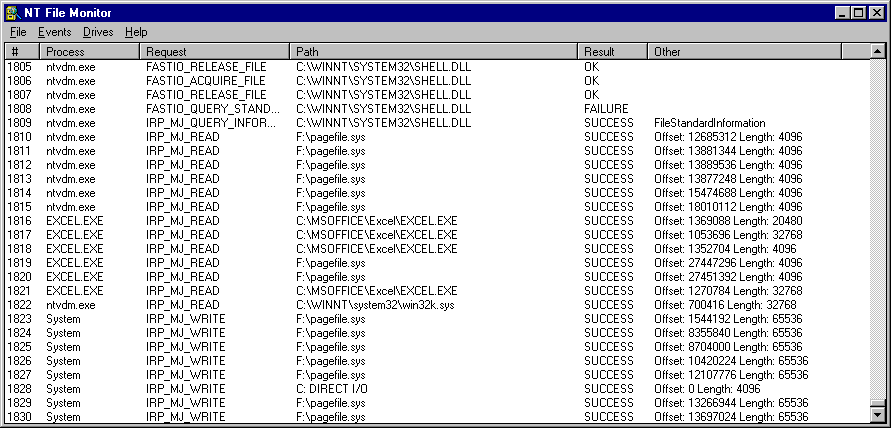
![[WebBoard, Web Conferencing System Software]](webboard_ad.gif)
Copyright (C) 1996, Mark Russinovich and Bryce Cogswell
FILEMON is a Windows NT GUI/device driver combination that intercepts and displays information about all file system activity on a Windows NT system. File systems monitored include FAT, HPFS, NTFS, CDFS, network redirectors and ram drives. Information displayed includes the request type, full pathname of the request target file, return status, and additional information specific to the request, such as read/write offsets and lengths. Even direct access of drives performed by utilities such as FORMAT and CHKDSK are visible to FILEMON.

By default, FILEMON monitors all non-removable drives on the system. The DRIVES menu indicates which drives are being watched by check-marking those drives. The monitoring status of a drive, such as a removable drive like a floppy, can be toggled at any time by selecting the drive letter in the DRIVES menu.
Next, Filemon creates a hook device object with IoCreateDevice; it attaches this object to the drive's device object, using IoAttachDeviceByPointer. This insures that Filemon will see all file system requests directed at the drive before the logical drive's file system driver sees the request.
When Filemon sees a request (the IO request packet [IRP] is passed to Filemon as part of the hook procedure's parameters), it extracts the request parameters and registers a completion routine (using IoSetCompletionRoutine) for the request so it can view the request's return status.
The Filemon GUI periodically performs a DeviceIoControl to the Filemon device driver, at which time the drive copies the latest batch of request information into a GUI-supplied buffer.
Visit these O'Reilly online areas:
![[O'Reilly Home]](http://www.ora.com/graphics/ora-nav.gif) Our homepage,
with product information, feature articles, and more.
Our homepage,
with product information, feature articles, and more.
![]() WebSite Central,
home of O'Reilly's hot, new, Windows Web server.
WebSite Central,
home of O'Reilly's hot, new, Windows Web server.
![[O'Reilly Windows Center]](http://www.ora.com/win/graphics/win-nav.gif) The O'Reilly Windows Center
has Win 95 programming information, articles, and links.
FTP site, with newer versions.
The O'Reilly Windows Center
has Win 95 programming information, articles, and links.
FTP site, with newer versions.